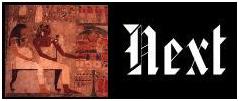The builder of the famous Step Pyramid at Saqqara is identified throughout his complex as the Horus Netjerikhet. An inscription left by the 19th Dynasty prince Khaemwaset, the famous son of Ramesses II, in the complex crediting the building to Djoser, has allowed us to equate the Horus Netjerikhet with Djoser(-Ti) of the king-lists. At least two other buildings, somewhat similar to Djoser's Step-Pyramid, have been started but left unfinished during the 3rd Dynasty as well: the buried pyramid at Saqqara and the layered pyramid at Zawiyet el-Aryan. Based on archaeological and architectural evidence, both monuments were built after Djoser's. In the buried pyramid of Saqqara, the oldest of the two, the Horus-name of Sekhemkhet has been found. If an inscription found in this pyramid may be interpreted as Sekhemkhet's Nebti-name, then Sekhemkhet may be equated to Djoser-Teti, the successor of Djoser in the king-lists. This interpretation is perhaps supported by the style and location of his pyramid and by the mention of Imhotep, the architect of Djoser's pyramid, in an inscription in Sekhemkhet's monument. In the pyramid of Zawiyet el-Aryan, no royal name has been found. In a tomb located in a nearby private cemetery, however, the Horus-name of Khaba was found. This has led archaeologists to believe that the layered pyramid of Zawiyet el-Aryan was built by the Horus Khaba. This king would then come after Sekhemkhet but before Huni, which places him at the fourth position in the king-lists: king Hudjefa.
Two other kings, known only through their Horus-names, have belonged to the 3rd Dynasty as well: the Horus Zanakht and the Horus Qa-Hedjet. Neither king can be placed with certainty. It has been suggested that Zanakht may have been the Horus-name of Nebka, but the archaeological evidence would rather point to Zanakht being a successor of Djoser and not a predecessor. The sole argument that supports the identification of Zanakht as Nebka is a sealing that contains the Horus-name Zanakht and the sign ka that could be interpreted as part of the nomen of the king. Since the archaeological evidence points to Zanakht being a successor of Djoser, it is more likely that Zanakht is the Neferkare noted in some king-lists. If this is indeed the case, then the 3rd Dynasty must at least have counted 6 kings in stead of 5. The equation of Qa-Hedjet with Huni is purely hypothetical as well and is not supported by any archaeological evidence.

